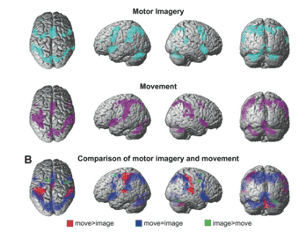Allyane Scientific Bases
The Allyane method
What is the Allyane method?
This innovation is based on solid scientific data, backed up by numerous recent publications in the field of neuroscience.
The Allyane method is based on three essential aspects:

A diagnostic assessment of excess neuromotor inhibition ;

Listening to low-frequency sounds (emitted by a patented medical device: Alphabox orAlphabimove);

Specific mental imagery work, where the patient becomes aware of the muscular sensations associated with the movement, and then translates them into mental images.
Scientific data
Scientific data on mental imagery
Several scientific research results demonstrate that the areas in the brain activated bymental imagery of a movement are largely identical to those activated when we perform that movement.
Hanakawa T, Dimyan MA, Hallett M. Motor planning, imagery, and execution in the distributed motor network: a time-course study with functional MRI.
Cereb Cortex. 2008 Dec;18(12):2775-88. https://doi.org/10.1093/cercor/bhn036. Epub 2008 Mar 20.
The activation of the brain is also different if we imagine a slow or fast movement, of low or high power.
Mizuguchi N, Nakata H, Kanosue K. Activity of right premotor-parietal regions dependent upon imagined force level: an fMRI study. Front Hum Neurosci. 2014 Oct 8;8:810. https://doi.org/10.3389/fnhum.2014.00810. eCollection 2014
Sauvage C1, Jissendi P, Seignan S, Manto M, Habas C. Brain areas involved in the control of speed during a motor sequence of the foot: real movement versus mental imagery. J Neuroradiol. 2013 Oct;40(4):267-80. https://doi.org/10.1016/j.neurad.2012.10.001. Epub 2013 Feb 21.
Scientific basis
Scientific basis in relation to muscular and motor sensations associated with sound stimulation
Several scientific studies show that the mental imagery of the Allyane protocols, enriched with muscular and motor sensations, is more effective than a simple visualisation.
Recent scientific publications also show us that sound stimulation combined with this motor imagery has a much better therapeutic effect.
Fernandez-Del-Olmo, M., Río-Rodríguez, D., Iglesias-Soler, E., & Acero, R. M. (2014). Startle Auditory Stimuli Enhance the Performance of Fast Dynamic Contractions. PLoS ONE, 9(1), e87805. https://doi.org/10.1371/journal.pone.0087805
Ikeda, K., Higashi, T., Sugawara, K., Tomori, K., Kinoshita, H., & Kasai, T. (2012). The effect of visual and auditory enhancements on excitability of the primary motor cortex during motor imagery: A pilot study. International Journal of Rehabilitation Research, 35(1), 82-84. https://doi.org/10.1097/MRR.0b013e32834d2032
See more publications
Naghdi, L., Ahonen, H., Macario, P., & Bartel, L. (2015). The effect of low-frequency sound stimulation on patients with fibromyalgia: A clinical study. Pain Research & Management, 20(1), e21-27. https://doi.org/10.1155/2015/375174
Calomeni, M. R., Feijó, G., & Bittencourt, J. M. (2017). Modulatory Effect of Association of Brain Stimulation by Light and
Binaural Beats in Specific Brain Waves. 11. Clin Pract Epidemiol Ment Health. 2017 Sep 14;13:134-144. doi:
10.2174/1745017901713010134. eCollection 2017.
Bartel, L. R., Chen, R. E. W., Alain, C., & Ross, B. (2017). Vibroacoustic Stimulation and Brain Oscillation: From Basic
Research to Clinical Application. 9(3), 14.
Other scientific studies are underway to improve our knowledge of the action of the Allyane method in order to further improve its effectiveness.
Scientific basis
Clinical studies
Published clinical studies attest to the clinical performance of the Allyane method in pathologies where motor inhibitions make rehabilitation difficult:
Management of AMI (Arthrogenic Muscle Inhibition) following knee trauma;
Range of motion deficit following shoulder surgery;
Motor skills and pain in chronic low back pain ;
Ankle instability ;
Spasticity and motor skills following a stroke**.
Studies are underway and others are planned to complete the body of clinical evidence available.
Chatain AL, Dorochenko P, Friggeri A. Contribution of an innovation in neuromotor reprogramming in shoulder pathologies. Poster presented at the 45th national congress of the French Society of Sports Physiotherapists SFMKS, SFPhysio. Saint-Etienne, France, 28/04/2018.
Chatain AL, Gonzalez Iglesias I, Friggeri A. Innovating in the management of spasticity with a non-invasive procedure. Kinesitherapy Scientific 2018; 599:37-41, France, June 2018.
See more publications
Chatain AL, Friggeri A. Innovating in the management of spasticitý. Poster presented at̀ la 1è̀re journée
française de neurokinésithé́rapie, SFPhysio. Marseille, France, 22/09/2018.
Friggeri A, Le Blay G Neuro-cognitive reprogramming in mechanical pathologies of the
locomotor system according to the Allyane process. Paper and workshop at the 12th SOFMMOO national congress, October 2018
Friggeri A, Le Blay G Neuro-cognitive reprogramming in the rehabilitation of chronic low back pain. Poster
presented at the 34th congress of the French Society of Rehabilitation Medicine SOFMER, October 2019
Chatain AL, Contribution of neuro-cognitive reprogramming in the management of spasticitý. Poster
presented at the 2nd Days of the French Neurovascular Society SFNV, Issy les Moulineaux, Nov 2019.
Jean Baptiste Colombié, PT, AT, A new way to change dance motor patterns: the Allyane process. Poster
presented at the 29th International Conference of the International Association for Dance Medicine & Science,
Montreal, Quebec, Canada, Oct 2019.
Chatain AL, Contribution of neuro-cognitive reprogramming in the management of spasticitý.
Paper and e-poster at the e-JNLF 4-6 September 2020.
Chatain AL, Impact of neuro-cognitive reprogramming in spasticity rehabilitation. Accepted poster in the ESO-
WSO Virtual Conference, 7-9 november 2020
Ladoucette S., Arthrogenic Muscle Inhibition: a new approach in joint rehabilitation. ECOSEP Congress Sports
Medicine and Science : Facts for the future, 19-20 November 2021, Athens



